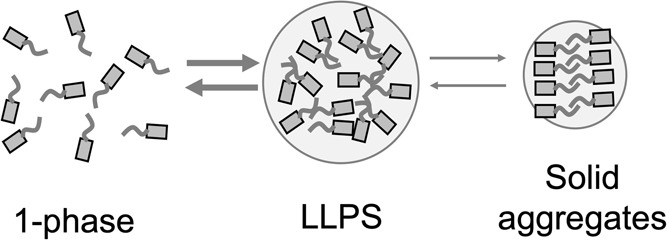Phase separation by biopolymers: Basics and applications.
Biophysics and Physicobiology
Pub Date : 2022-08-24
eCollection Date: 2022-01-01
DOI:10.2142/biophysico.bppb-v19.0028
引用次数: 0
Abstract
In recent years, various intracellular components, such as P-bodies, nucleoli, and stress granules, have been shown to be aggregates of proteins and RNA via liquid–liquid phase separation (LLPS) [1]. Since such protein granules can reversibly form, disappear, and play their respective roles in the cell, they are called membraneless organelles. To date, many proteins, especially nuclear proteins, and artificial peptides have been reported to form protein granules, namely condensed liquid droplets, via LLPS (Figure 1) [2,3]. Interestingly, amyloid fibril formation is gradually accelerated in droplets [4]. By elucidating the formation mechanism of irreversible aggregates from the homogeneous phase state (1-phase) of proteins via liquid droplets in vitro and in vivo, effective drugs can be developed for neurodegenerative diseases. To discuss the cutting-edge research on the LLPS of biopolymers [5-9], the “Phase Separation by Biopolymers: Basics and Applications” symposium will be held at the 60th Annual Meeting of the Biophysical Society of Japan in September, 2022. The invited speakers at the symposium will be Ryo Kitahara, Akira Nomoto, Shinji Kajimoto, Kiyoto Kamagata, and Tomoshi Kameda. Kitahara et al. will introduce a pressure-temperature phase diagram of LLPS for fused in sarcoma (FUS) and the application of a pressure-jump spectroscopic technique to study the formation and vanishing dynamics of FUS-LLPS [6,7]. Nomoto et al. will discuss the solubility parameters of amino acids during LLPS and the aggregation of proteins, based on the solubility of aromatic amino acids in a solution containing 20 different amino acids [5]. Kajimoto et al. will explain Raman and Brillouin microscopy as a tool for quantitative analysis of LLPS. This method is a powerful technique to determine the chemical nature of LLPS and its relationship with protein aggregation [9]. Kamagara et al. will introduce rational peptide design for regulating LLPS on the basis of residue-residue contact energy. The effects of designed peptides on p53 LLPS analysis will be discussed [8]. Kameda et al. will introduce theoretical approaches combined with molecular dynamics simulations and machine learning. The aggregation nature of tetra-peptides will be discussed.

生物聚合物相分离:基础和应用。
本文章由计算机程序翻译,如有差异,请以英文原文为准。
求助全文
约1分钟内获得全文
求助全文

 求助内容:
求助内容: 应助结果提醒方式:
应助结果提醒方式:


